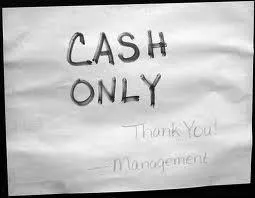The Faster Growth Now Blog

Tried and True Ways To Push Away Customers Forever
Tried and True Ways To Push
Away Good Customers
If that question makes sense to you, then you can safely skip the rest of this post…
But if it tickled a little thought in the back of your mind, read on.
Consider this: Since the start of the last worldwide recession, many businesses have tightened their credit policies so that only the best-rated customers get payment terms. Everyone else has to pay cash.
Do you do anything like this? Sure, it makes sense to hold down “unnecessary costs” and avoid risky business. But have you bothered to figure out whether net profits are up as a result?
I’m willing to bet that at the end of the day, tight credit policies are costing tons of money in missed sales, and that the “saved” losses are dwarfed by the missed opportunity, the lost life-time value, simply because it’s harder to do business with you than with your competitors.
Losing repeat business... Forever
And that’s just one example of how companies push away perfectly good customers. There are tons of proven ways to lose sales by making it extra hard for customers to buy from you. Mostly, these are just bad decisions people make to limit expenses, but they are almost always shortsighted. They repel good customers, and not only for the all-important first sale, but for all the otherwise super-profitable recurring sales as well.
Once pushed away, those potential customers are pushed away forever. They never come back for that ever-more-valuable repeat business.
Here are some other ways business owners make it hard for customers to buy.
Limiting forms of payment.
I like to eat at a local place that serves a fabulous “Mediterranean Frittata” with a wild green salad. But they only take cash. What a pain. It makes me think twice about meeting people there, and I never go with a big group. Who wants to peel off $300 in cash for breakfast? Of course, they save anywhere from 1.9% to 3.5% on each diner, and that’s not nothing. But what about all the lost business?
The list of widely used payment options is not long. Online, you can use credit and debit cards: Visa, Master Card, American Express, and Discover), PayPal, or electronic or e-Checks. Offline, you’ve got the cards, plus checks and cash. That’s pretty much it.
Why on earth would you not accept ALL of them? To save 1% on the transaction free?
Suppose someone doesn’t have a Visa or Master Card because they’ve gone over their limit and their bank has shut them down. But AMEX plays by different rules so they actually have plenty of spending power. But you’re wiling to lose the sale in order to keep 1% of extra margin.
By the way, 1% saved on nothing is nothing.
And 1.9% saved, or even 3.5% saved on nothing, is still nothing.
Online, it’s even worse. At least offline, the customer is already in the store, and has maybe consumed the purchase already, so they pay. Online, they just abandon the shopping cart. Many smaller businesses only accept PayPal and don’t take cards at all, which is just nuts. I estimate it cuts into their sales by 30–50%.
Wake up! You’ve spent all this energy getting shoppers to your store. Why not make it easy for them to give you their money?
Shipping and Handling
Another area doing business is made harder than it needs to be is shipping, and the mysterious “handling.” I’m not sure who people think they’re fooling when they add $28.00 to ship something everyone knows costs $4.95 to deliver. If I discover it before clicking the order button, I usually ditch the vendor, just out of spite.
Automated shopping cart systems make it easy to give customers a choice of shipping methods tailored to their needs and their budget.
Easy + Fast + Cheap = Repeat Business.
Or do what Zappos does and ship for free. More and more e-tailers are doing it and those who don’t will get left behind. Make it easy for people to get their stuff and they’ll want to get it from you. One of the reasons cited for Zappos incredible success (and $800 Million sale to Amazon) is free shipping, even on returns. And get this – choose the free shipping option and they still send it overnight. Now that’s easy.
You can’t always find what you want…
Make it easy for customers to find stuff. Online, give them search capability that actually finds things and make the search box PROMINENT on every page. And since shelf space is infinite, feature the same products on every appropriate category page.
Offline, organize your store to match how customers think about products. Use big readable signs, along with on-shelf labeling. Scatter specials around your store. Put them right in the traffic flow. Supermarkets are great sources of merchandizing inspiration, study what they do. And add staff to helpfully direct shoppers. Train them to ask, “How can I help you?” instead of “Can I help you?”
Grease the Wheels
What about handling the transaction itself? Offline this isn’t much of a problem, except in my local Ralphs. They’re great merchandisers but now they’re pushing automated checkout and the scanners don’t work very well. The machines bark rudely at you and the “place the item in the bag” system is clumsy and inefficient. Plus it’s impossible to pay for self-serve items from the “olive bar.”
But I was in the new Fresh and Easy the other day, and they’ve rethought the whole process. Every bad aspect in the Ralph’s system works beautifully here. Now I know it’s possible to get it right.
Online, checkout can be hard if you can’t find the checkout button or the “show my cart” button. Or what about losing your order information when you accidently hit the back button. And why can’t your shopping cart handle dashes in my phone number. What’s wrong with dashes? And why wouldn’t your system save things in my cart for a day, or even two? Get interrupted and have to start over again? How frustrating. How inconvenient. Amazon saves things in my cart… forever.
Did you know that 70% of all orders started in a shopping cart don’t complete? Put some thought into improving your process, and it could pay hugely.
Faxing in the Age of the Internet
This one is my absolute favorite. I tried to purchase an exotic version of the antioxidant glutathione from a company in New York. The only way is to print out their order form, write my order by
Sources of Friction
Here are a few other sources of friction you may wish to consider.
Is your store open hours long enough, or early enough, or late enough?
Do you have enough staff for the volume of shoppers?
Is your customer service line responsive?
Are your on-hold times out of whack?
What about your toll-free phone numbers? Easy to find, prominently posted?
Is your phone tree a button-pushing nightmare? “Please listen carefully because our menu has recently changed…” Don’t waste my time, just tell me what I need to know, and ALWAYS give me the option of talking to an operator. Outsource this if you don’t have your own.
If you have online chat, make sure it’s available most of the time. People aren’t idiots, and when your chat is always closed, they know you’re scamming them with some “conversion tactic” you read in a blog post.
Think about your customer’s buying process. What steps do they have to go through to make a purchase. Where do they get hung up? Where is it harder than it needs to be. Find the sources of friction and reduce or remove them.
By the way, the people running Amazon are the kings of this. They continually refine their e-commerce system to reduce friction and make the buying process easier and easier.
One-Click is perhaps the most friction-free method of buying anything anywhere, and it gets smarter and smarter over time.
What is you version of “one-click?” Figure that out and your sales could jump quite a bit.

